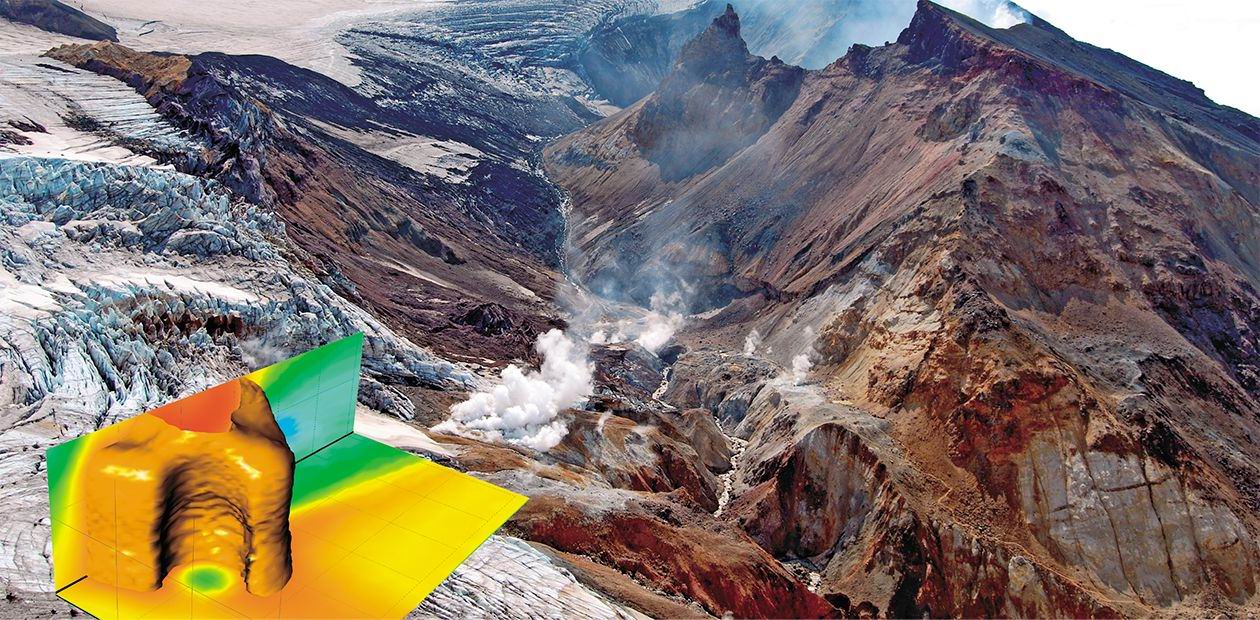Hot Blood of the Earth Non-Invasive Diagnostics for Volcanoes
Some events taking place at active volcanoes reflect the processes happening deep inside our planet. Therefrom comes up along natural channels the “blood” of the Earth, namely, thermal fluids carrying up to the surface mixtures rich in rare-earth elements. With the help of geoelectric investigations and physicochemical modeling, scientists obtain information about the migration pathways of these elements. Practically, these studies imply developing new methods for the search of ore and thermal water deposits
Active volcanoes are unique geological objects; their flanks and craters often feature springs of thermal water and gas. These phenomena reflect processes happening in hot deep layers of the Earth as the areas of contemporary volcanism are connected with active geodynamic zones (Dobretsov et al., 2001). In particular, all active volcanoes in Russia were formed over subduction zones, areas where the oceanic plate is sliding beneath the continental plate. In some places, the rock material melts forming magma chambers. Geothermal streams flowing onto the surface apparently originate from the hot melt coming out of these chambers.
Groundwater, where heat and mass transfer occurs, has a dominant role in the formation of volcanic thermal solutions. Being filtered through volcanogenic rocks, groundwater leaches out selected chemical elements, which results in their dissolution. The groundwater solution includes rock-forming elements (silica, aluminium, calcium) and impurities (microelements). However, most of them never reach the surface, which is accounted by the difficulties they face on the way up.
FUMAROLES are sources of hot gases emerging from magma through an opening in the crater or on the volcano slope. As a rule, a dense steam is wreathing over big fumaroles due to a high content of water in magma, which is condensed in the cold air. In addition to steam, carbon dioxide, hydrogen sulfide, hydrogen halides and other gases are emitted through fumaroles.THERMAL SPRINGS are springs of hot (thermal) highly mineralized water spurting in active volcanic areas. Chemical composition and temperature of the solution discharged vary.
GEYSERS are springs regularly spurting hot water and steam
Uprising from the inferno
On their way up to the surface, the ascending streams of magmatic fluid encounter various obstacles appearing due to varieties in the permeability of the Earth’s crust layers forming various fanciful configurations. Because of these geostructural features, the migration pathways of the fluids to the surface represent crooked lines, which can multiply branch and intercross.
Adjacent layers (horizons) of volcanogenic rocks sometimes differ substantially in their physicochemical properties. The boundary between them acts as a kind of semipermeable barrier since the fluid passing through it can undergo phase separation with different flow rates of the phases. In the case of transition of the elements between the phases, a geochemical barrier is considered to form.
For instance, a decrease in permeability leads to an increase in stream pressure, which can cause condensation and segregation of a gaseous fluid into fluid condensate and saturated moist steam. A similar phenomenon results from interaction of the fluid with cold groundwater. In the latter case, the condensate can mix with the water, and the extent of mixing (dilution) and ion exchange is determined by the temperature difference and relationship between the fluid and water flow.
Entering a high permeability layer, on the contrary, leads to an abrupt drop of pressure. The liquid fluid can boil, which promotes partial transfer of volatile components (CO2, H2S, HCl, etc.) into the vapour phase (separate) whereas metal hydroxides and salts stay and concentrate in the liquid condensate. Under favourable conditions, the ore-bearing fluid generated in this way can eventually form an ore deposit.
On the way up to the Earth’s surface, the fluid can undergo multiple transitions between the gaseous and liquid states. In this case, mass transfer processes determine the change of physicochemical properties (particularly, element composition) of thermal solutions on their way up and until the moment when the elements reach the Earth’s surface.
It is important to notice that the mass transfer processes are usually incomplete (i. e., do not proceed “to the finish”). This means that the final solution flowing from the spring contains traces of all the elements, though most of them could have been lost on the way up. From these traces, in principle, one can not only read the history of the spring genesis but also predict where to search for the “losses.”
Looking for a treasure
Practical prediction of ore deposits requires more detailed and fundamental, systemized in the frames of a unified theory, knowledge of the origin and evolution of hydrothermal fluids. Studies of contemporary volcanoes help scientists obtain factual information (a set of hydrogeochemical and geophysical data) essential for elaborating such a theory.
Geochemical barrier is a zone of an abrupt decrease in the migration ability of certain chemical elements. This process is accompanied by their precipitation from the thermal solution, which results in a local increase in the concentration of these elements in the rock. In this manner, geochemical barriers play an important role in the processes of ore formationThe first step is to examine the structure of the hydrothermal system within a volcano and to comprehend the processes and mechanisms of leaching and precipitation of chemical elements during the fluid migration. Here, physicochemical modeling plays an important role. However, in order to detect the conditions of formation of the groundwater salt composition, scientists should rely on actual measurable physicochemical parameters of the groundwater and surrounding rocks (temperature and conductivity, ratio of main ions and microelements, gas composition, etc.).
Field investigation of an object is complicated by the presence of the mobile phases. Taking depth samples through mechanical drilling would inevitably destroy the stream structure inside the hydrothermal system. Therefore, this method cannot provide a real picture of the processes under study.
Fortunately, in the last few years, geophysicists have been intensively developing methods of non-destructive remote control. For example, it is possible to determine from ground conductivity what kind of phase (gas or fluid) fills the ground as well as the degree of its permeability.
Nondestructive methods, in particular electrotomography and frequency electromagnetic sounding (FEMS), have found application in civil engineering and archaeology. With the help of both methods, a map of ground inhomogeneities differing in electrical resistivity (ER) is obtained.
Electrotomography is a better developed and more reliable technique. In geoelectrics, it can fairly be considered as a reference point method providing the most precise depth values. The tool more informative for detecting the phase structure of hydrothermal systems is frequency sounding.
ELECTROTOMOGRAPHY
To conduct an electrotomographic survey of the ground, electricity is supplied to a set of grounded electrodes. This produces an electrical field, which can be digitized by measuring electrical potential at the surface along the current flow. The digital field pattern allows calculation of electrical resistance (ER) of the ground in the key points of a vertical cross-section.A series of parallel geoelectrical cross sections provides information necessary for the construction of a 3D ER map of the near-surface ground layer. The map serves to study the geometrical features of the rocks and fluids composing this layer.
This method can be applied even if the area studied has a highly inhomogeneous structure with a wide range of ER values, which is typical of hydrothermal objects.
The penetration depth of the measurements is limited to several tens of meters, whereas localization accuracy is up to one meter
Hot blood
In Russia, during the last decade, Mutnovsky (South Kamchatka) and Ebeko (north of the Kurile Islands) volcanoes have been active, which is certainly exciting for geologists.
Thermal solutions in these volcanoes are highly acid (рН can be up to 0.5), with chorine and sulphur as the main chemical elements of the acid-forming anions. Cation composition is more variable and includes dozens of metals.
FREQUENCY SOUNDING
Frequency sounding method is based on the phenomenon of electromagnetic induction. An electromagnetic signal is generated in the ambient space and an ER distribution map is obtained using mathematical processing of a reflection signal. This method, unlike electrotomography, does not require an ohmic contact to the ground.Sounding depth is determined by the signal frequency and, as a rule, limited to several meters
Moreover, scientists point at a highly interesting fact: the waters of two thermal springs located a few meters from each other are radically different in their cation composition. What is the reason for this phenomenon? The mass flows feeding these thermal springs seem to have the same source and pass through the same rock masses to the surface almost next to each other.
An unknown reason for the hydrochemical inhomogeneity of closely spaced thermal springs motivated the scientists from the Institute of Geology and Mineralogy and Institute of Petroleum Geology and Geophysics (IPGG) of the Siberian Branch of the Russian Academy of Sciences (SB RAS) to initiate collaborative investigations of these volcanoes in order to trace the migration paths of the solutions and the transformations they undergo on their way to the surface.
It should be noted that the Earth’s surface layers are characterized by high vertical gradients of temperature and oxygen concentration. Such a geochemical barrier is a favorable factor for substance deposition at a shallow (about ten meters) depth. Therefore, studying the thermal fields in close vicinity to the Earth’s surface is of great interest. For the first time in Russia, Siberian scientists have applied for this purpose near-surface geophysical methods – electrotomography and frequency electromagnetic sounding (FEMS).
Electrotomography helps to detect inhomogeneities at a depth of several tens of meters. However, the spatial resolution of this method is not high. Frequency sounding provides a higher resolution but a lower depth limit. Therefore, the two techniques were applied sequentially: first, electrotomography was used to obtain an approximate ER map under the area in question; then, the map helped to identify the places most interesting for geochemical survey. After this, detailed sounding was performed by frequency sounding devices.
During the field studies, the scientists used not only conventional methods but also techniques developed especially for the investigation of hydrothermal springs. One of them involved imposition of a constant electrical field during frequency sounding, which allowed for a more resolved pattern of porous-saturated channels.
Wonderful contrasts
At the thermal area of the Donnoye field of Mutnovsky volcano, there are mud pools with a unique association of chemical elements containing titanium, vanadium, chromium, nickel, rare-earth elements and platinum group metals of abnormally high concentrations (Bortnikova et al., 2009). The use of purely chemical analytical methods failed to explain the anomalous composition of the thermal solutions.
With the help of FEMS, scientists have successfully traced channels near the surface (at a depth of 5—8 m), through which thermal solutions and gas move simultaneously. It has been found out that hydrothermal solution streams are not distributed uniformly in the space under the thermal area but grouped into zones. Note that the streams differing in their phases do not mix with each other, which accounts for a wide variety of thermal muds.
Also, the Donnoye field has so called “red reservoirs,” hematite pools containing a great amount of ferrous iron. Until recently, their contrasting chemical composition has been inexplicable. FEMS has indicated small but quite distinctive channels feeding these thermal springs.
On Ebeko, hydrothermal deposition of the substances of endogenous origin takes place mainly at the Severo-Vostochnoye fumarole field. The ER distribution on a three-dimensional electrotomographic map gives clear evidence on the presence of a gas-vapour zone. Nearer the surface, it turns into a zone of highly mineralized solutions, where substances are separated from the gas-vapour stream and transferred into the water phase. These processes represent the evolution of sequential formation of the solution.
Hence non-destructive control methods applied to the study of the feeding channels of active hydrothermal springs and subsurface phase barriers have demonstrated excellent results for volcanology.
Regrettably, so far parameters of physicochemical transformations of substances cannot be measured experimentally in situ, i.e., under natural conditions. However, knowing properties of each separate substance, it is possible to predict, with a certain degree of approximation, their potential transformations. This speculative procedure based on field studies data (an input data set) is referred to as physicochemical modeling.
So the results of physicochemical modeling allowed elucidation of several important principles, based on which a hypothesis about migration of chemical elements from the magma chamber to the surface has been proposed. It was accepted as a basis for the developed conceptual model of volcano-hydrothermal systems.
The model implies the presence of a shallow (located less than 3 km beneath the surface) magma chamber and a well-penetrated vertical channel, surrounded by rock mass, along which hot fluids come up to the Earth’s surface.
Some elements, carried by the magmatic fluid, originate from a primary melt; the others are leached (extracted) from the rocks on the way up. A contact of fluids with a groundwater aquifer leads to the cooling and dilution of thermal solutions though it does not influence their chemical pattern, according to the modeling results.
The phase separation effect makes an important contribution to the solution concentrating process. It was found out that condensation occurs mainly because of the cooling of solutions as they move away from an internal heat source, and boiling takes place as a result of a pressure drop as they enter a lower density layer. Both phase transitions lead to an enrichment of the liquid solution with metals and transfer of the elements forming volatile hydrides to a gas phase.
This is a general description of the generation of ore-bearing fluids, which can form ore deposits under favorable conditions.
It goes without saying that a lot of questions on the genesis of thermal solutions still remain to be answered. In our further investigation we plan to study real phase barriers (localization, physical and chemical properties, mechanism of the fluid stream impact) as well as to determine the conditions favorable for the deposition of ore-forming elements.
To achieve these goals, a more advanced numerical model of physicochemical interactions between fluids and rocks is being developed, which would take into account a possibility of phase transitions and energy balance of the processes at work.
References
Balkov, E. V., Epov, M. I., Manstein, A. K. Frequency electromagnetic sounding: estimation of penetration depth // Geofizika, 2006. No. 3. P. 41—44.
Bessonova, E. P. et al. Physicochemical modeling of hydrothermal transformation of andesites of the Ebeko volcano, the Kurile Islands // Vulkanologiya i Seismologiya, 2004. No. 4. P. 56—64
Bobachev, А. А. et al. Electrotomography by the method of resistances and induced polarization // Pribory i sistemy razvedochnoi geofiziki, 2006. No. 2. P. 14—17.
Bortnikova, S. B., Gavrilenko, G. M., Bessonova, E. P., Lapukhov, A. S. Hydrochemistry of thermal springs on Mutnovsky volcano (South Kamchatka) // Vulkanologiya i Seismologiya, 2009. No. 6. P. 1—18
Dobretsov, N. L., Kirdyashkin, A. G., Kirdyashkin, А. А. Deep-level geodynamics. SB RAS, Publ., Geo Branch, 2001. Novosibirsk. 408 pp.
Epov, M. I. From the depths of Siberian mines // Science First Hand (Russ.), 2009. No. 4(28). P. 60—73.
Manstein, A. K., Panin, G. L., Tikunov, S. Yu. A device for shallow frequency-domain electromagnetic induction sounding “EMS” // Geologiya i Geofizika, 2008. V. 49. No. 6. P. 571—579.
Manstein, Yu. A. et al. Structural features in the channels of thermal spring on the Mutnovsky volcano (South Kamchatka) // Doklady RAS, 2008, V. 423. No. 3. P. 383—388.
We thank the team of the Kurils-Kamchatka expedition from the Institute of Petroleum Geology and Geophysics and the Institute of Geology and Mineralogy SB RAS, as well as our colleagues from the Institute of Volcanology and Seismology, RAS Far East Branch.
The work was supported by grant of the President of the Russian Federation RF MK-167.2010.5, of integrated project of SB and FEB RAS No. 96.
Photos are the courtesy of A. Ya. Shevko, Candidate of Geology and Mineralogy (Institute of Geology and Mineralogy SB RAS, Novosibirsk)






